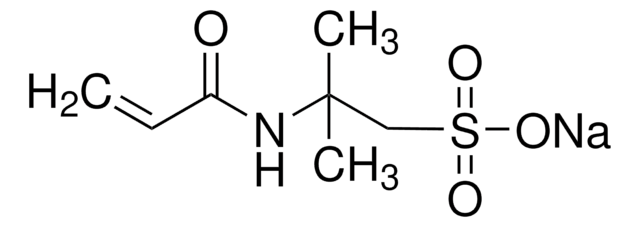If this product has an expiration or retest date, it will be shown on the Certificate of Analysis (COA, CofA). If there is no retest or expiration date listed on the product's COA, we do not have suitable stability data to determine a shelf life. For these products, the only date on the COA will be the release date; a retest, expiration, or use-by-date will not be displayed.
For all products, we recommend handling per defined conditions as printed in our product literature and website product descriptions. We recommend that products should be routinely inspected by customers to ensure they perform as expected.
For products without retest or expiration dates, our standard warranty of 1 year from the date of shipment is applicable.
For more information, please refer to the Product Dating Information document: https://www.sigmaaldrich.com/deepweb/assets/sigmaaldrich/marketing/global/documents/449/386/product-dating-information-mk.pdf
Kluczowe dokumenty
278424
Poly(vinylsulfonic acid, sodium salt) solution
30-40 wt. % in H2O, technical grade
Synonim(y):
PVSA
Wybierz wielkość
403,00 zł
Wybierz wielkość
About This Item
403,00 zł
Polecane produkty
klasa czystości
technical grade
Poziom jakości
Formularz
liquid
stężenie
30-40 wt. % in H2O
współczynnik refrakcji
n20/D 1.389
gęstość
1.267 g/mL at 25 °C
ciąg SMILES
[Na]OS(=O)(=O)C=C
InChI
1S/C2H4O3S.Na/c1-2-6(3,4)5;/h2H,1H2,(H,3,4,5);/q;+1/p-1
Klucz InChI
BWYYYTVSBPRQCN-UHFFFAOYSA-M
Powiązane kategorie
Zastosowanie
- In the preparation of superabsorbent semi-IPN (interpenetrating polymer network) hydrogel.
- As a solid electrolyte for proton conduction in the fabrication of an all-solid-supercapacitor.
- As a crystallization controlling agent in the preparation of high-quality crystals of porous coordination polymers(CP). PVSA regulates not only the size and structure of the crystals but also their preference orientation, resulting in CP channel alignment in the bulk powdery state.
Hasło ostrzegawcze
Warning
Zwroty wskazujące rodzaj zagrożenia
Zwroty wskazujące środki ostrożności
Klasyfikacja zagrożeń
Eye Irrit. 2 - Skin Irrit. 2 - STOT SE 3
Organy docelowe
Respiratory system
Kod klasy składowania
10 - Combustible liquids
Klasa zagrożenia wodnego (WGK)
WGK 3
Środki ochrony indywidualnej
Eyeshields, Gloves, type ABEK (EN14387) respirator filter
Wybierz jedną z najnowszych wersji:
Masz już ten produkt?
Dokumenty związane z niedawno zakupionymi produktami zostały zamieszczone w Bibliotece dokumentów.
Klienci oglądali również te produkty
Produkty
Recently, layer-by-layer (LbL) assembly has emerged as a versatile, gentle and, simple method for immobilization of functional molecules in an easily controllable thin film morphology.1,2 In this short review, we introduce recent advances in functional systems fabricated by using the mild, yet adaptable LbL technique.
Montaż warstwa po warstwie oferuje wszechstronną metodę unieruchamiania cząsteczek funkcjonalnych w cienkich warstwach o kontrolowanej morfologii.
We present an article that discusses two applications in particular; first, using these layers as polyelectrolyte membranes to control permeability.
-
How can I determine the shelf life / expiration / retest date of this product?
1 answer-
Helpful?
-
-
How is shipping temperature determined? And how is it related to the product storage temperature?
1 answer-
Products may be shipped at a different temperature than the recommended long-term storage temperature. If the product quality is sensitive to short-term exposure to conditions other than the recommended long-term storage, it will be shipped on wet or dry-ice. If the product quality is NOT affected by short-term exposure to conditions other than the recommended long-term storage, it will be shipped at ambient temperature. As shipping routes are configured for minimum transit times, shipping at ambient temperature helps control shipping costs for our customers. For more information, please refer to the Storage and Transport Conditions document: https://www.sigmaaldrich.com/deepweb/assets/sigmaaldrich/marketing/global/documents/316/622/storage-transport-conditions-mk.pdf
Helpful?
-
-
What causes the difference between the yellow and amber colors of this product?
1 answer-
The quality specification for this item is only a residue on evaporation and appearance (color and form) assay for this technical grade product. Differences in color could be from numerous causes such as overall polymer composition, color perception, or appearance of raw material. It is not uncommon for the poly(styrenesulfonic acid sodium salt) to have color variations.
Helpful?
-
-
Hello, Just to confirm does the concentration of PVS vary from 30-40% in this raw material? Does 'Residue on evaporation' refer to the concentration of just PVS and not any impurities also in the raw material? I need to know the concentration of PVS.
1 answer-
Residue on evaporation refers to any solid material remaining after evaporating the water away. This value does not take into account potential impurities present in addition to the Poly(vinylsulfonic acid, sodium salt). Therefore, the concentration may vary slightly from the value provided on the lot-specific Certificate of Analysis.
Please access the link below to download a Certificate:
https://www.sigmaaldrich.com/product/aldrich/278424#product-documentationHelpful?
-
-
What is the pKa of this Poly(vinylsulfonic acid?
1 answer-
The pKa value is not determined for this product.
Helpful?
-
-
What is the average molecular weight of the SIgma Poly(vinylsulfonic acid, sodium salt)?
1 answer-
The molecular weight between 2000 and 5000 g/mol.
Helpful?
-
Active Filters
Nasz zespół naukowców ma doświadczenie we wszystkich obszarach badań, w tym w naukach przyrodniczych, materiałoznawstwie, syntezie chemicznej, chromatografii, analityce i wielu innych dziedzinach.
Skontaktuj się z zespołem ds. pomocy technicznej












